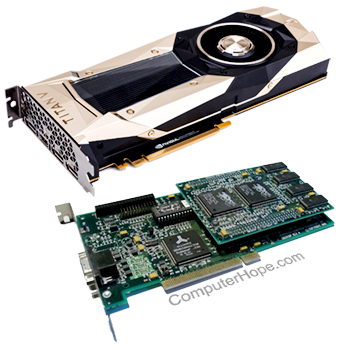Computer video card history

Listed below are the important events in history relating to video cards, including release dates for many popular video cards and the technologies included with them.
1981
IBM developed its first two video cards, the MDA (monochrome display adapter) and CGA (color graphics adapter), in 1981. The MDA had 4 KB of video memory, and the CGA had 16 KB of video memory.
1982
Hercules Computer Technology, Inc. developed the HGC (Hercules Graphics Card), its answer to IBM's video cards. Hercules took the MDA standard from IBM and combined it with bitmapped graphics, and set the HGC with 64 KB of video memory.
1983
Intel entered the video card market by introducing the iSBX 275 Video Graphics Multimodule in 1983. It was capable of displaying eight colors and a 256 x 256 resolution.
1984
IBM introduced the PGC (Professional Graphics Controller) and the EGA (enhanced graphics adapter) in 1984.
1987
The VGA (video graphics array) standard was released in 1987, providing a video resolution of 640 x 480 with 16 colors and up to 256 KB of video memory.
ATI introduced its first VGA video card, the ATI VGA Wonder. Some VGA Wonder cards even featured a mouse port for mouse connectivity.
1991
S3 entered the video card market with its S3 911 and 911A graphics chips, which provided up to 256-color graphics quality. S3 mostly sold its graphics chips to OEM (original equipment manufacturer) manufacturers to integrate into computer motherboards, due to its low cost and lower quality.
1992
Developed by Silicon Graphics Inc., OpenGL was released in June 1992. OpenGL was used to render 2D and 3D vector graphics in video games, CAD (computer-aided design), virtual reality, and other applications.
1996
The first of the Voodoo line of video cards was introduced in 1996 by 3dfx, called the Voodoo1. It required a 2D video card to be installed in a computer, allowing it to run alongside and provide 3D graphics rendering for computer gamers. Voodoo video cards quickly became popular amongst computer gamers.
1997
NVIDIA released its RIVA 128 graphics accelerator chip, allowing video card manufacturers to incorporate 2D and 3D graphics acceleration into its video cards. The RIVA 128 chip was intended to be NVIDIA's answer to the Voodoo1 video card, but it had lower-quality graphics rendering.
1998
3dfx released the Voodoo2 video card in February 1998, replacing the Voodoo1. It was the first video card to support SLI (Scalable Link Interface), allowing two video cards to work together for superior graphics.
1999
NVIDIA released the GeForce 256 GPU (graphics processing unit) on October 11, 1999. It was considered the first GPU worldwide and fully supported DirectX 7. It also featured 32 MB of DDR (double data rate) memory.
2000
ATI introduced the Radeon R100 series video cards in 2000, beginning a long-lasting legacy of the Radeon line of video cards. The first Radeon video cards were fully DirectX 7 compatible and featured ATI's HyperZ technology.
2001
NVIDIA released the GeForce 3 series of video cards in March 2001. The GeForce 3 series were the first video cards in the world to feature programmable pixel shaders.
2002
ATI released the Radeon 9700 video card in October 2002, the first Direct3D 9.0 accelerator video card on the market.
2006
ATI was acquired by AMD in 2006. AMD no longer used the ATI name for the Radeon video card series.
2010
Audi began using the NVIDIA Tegra GPU to power the dashboard in its cars in 2010.
2013
Sony and Microsoft released the PlayStation 4 and Xbox One in 2013. Both gaming consoles used a GPU based on AMD's Radeon HD 7790 and 7850 video cards.
2020
NVIDIA announced it acquired Arm for $40 billion on September 13, 2020.
NVIDIA released its highly anticipated RTX 30 series graphics cards in September and October 2020.
